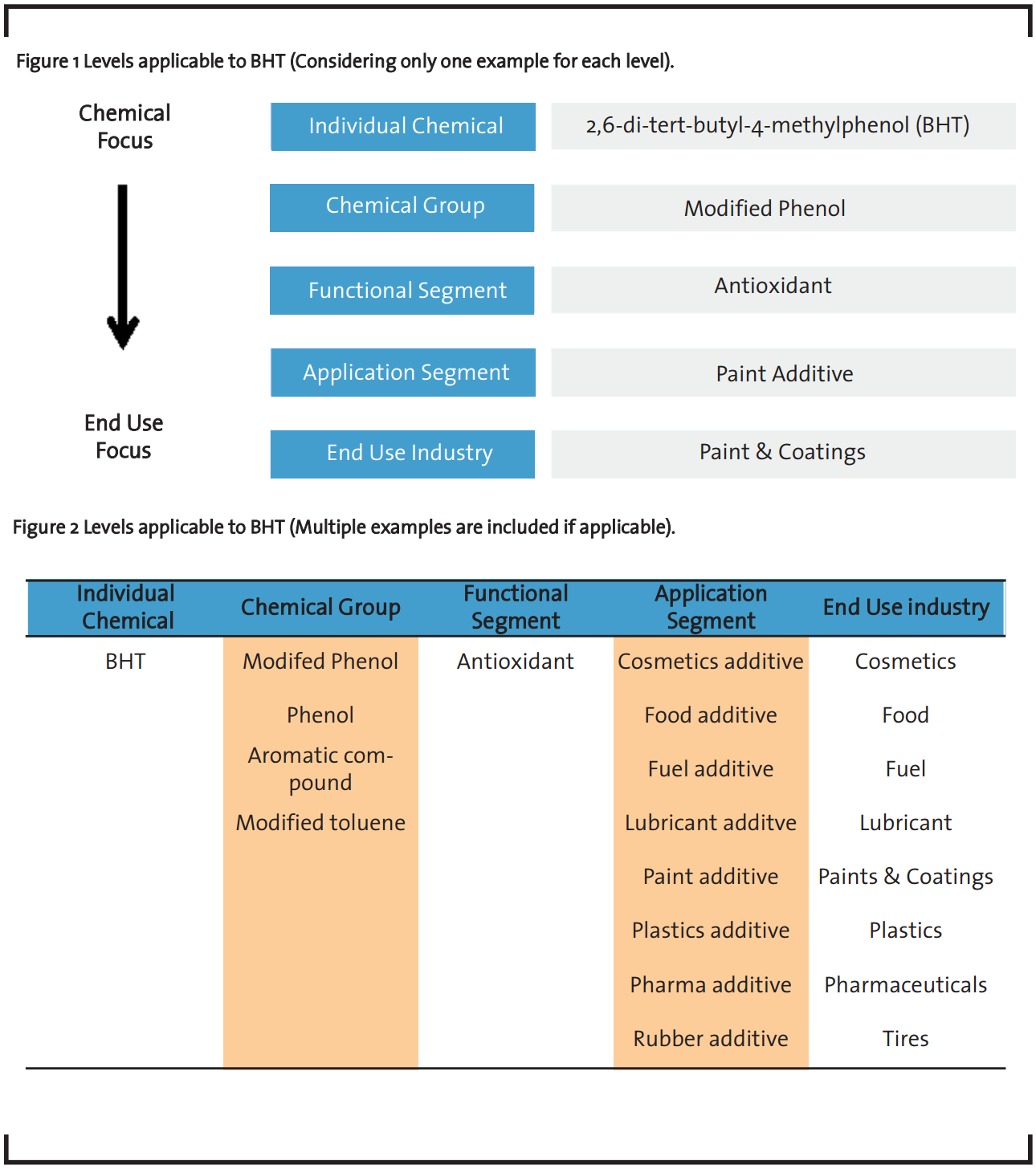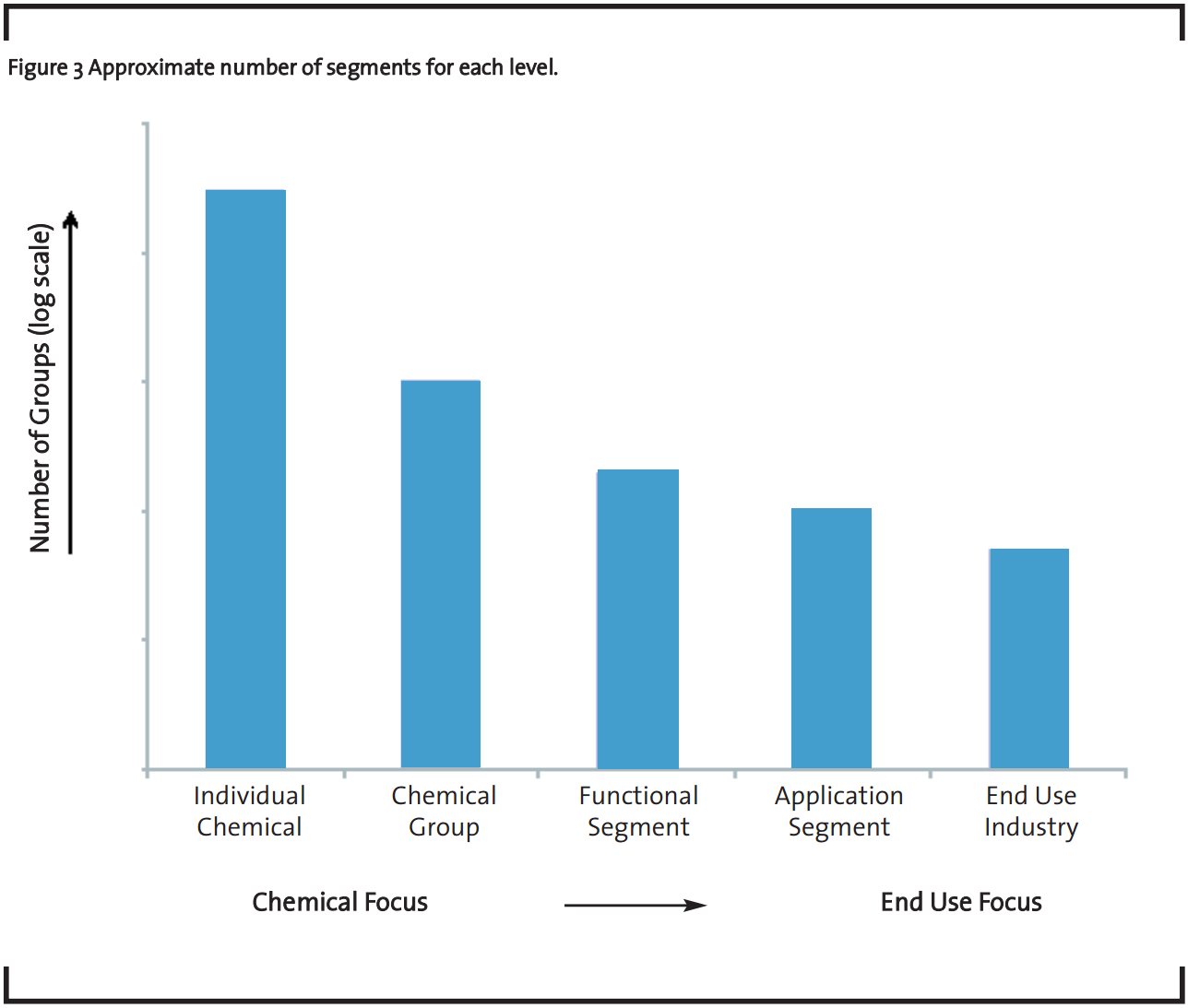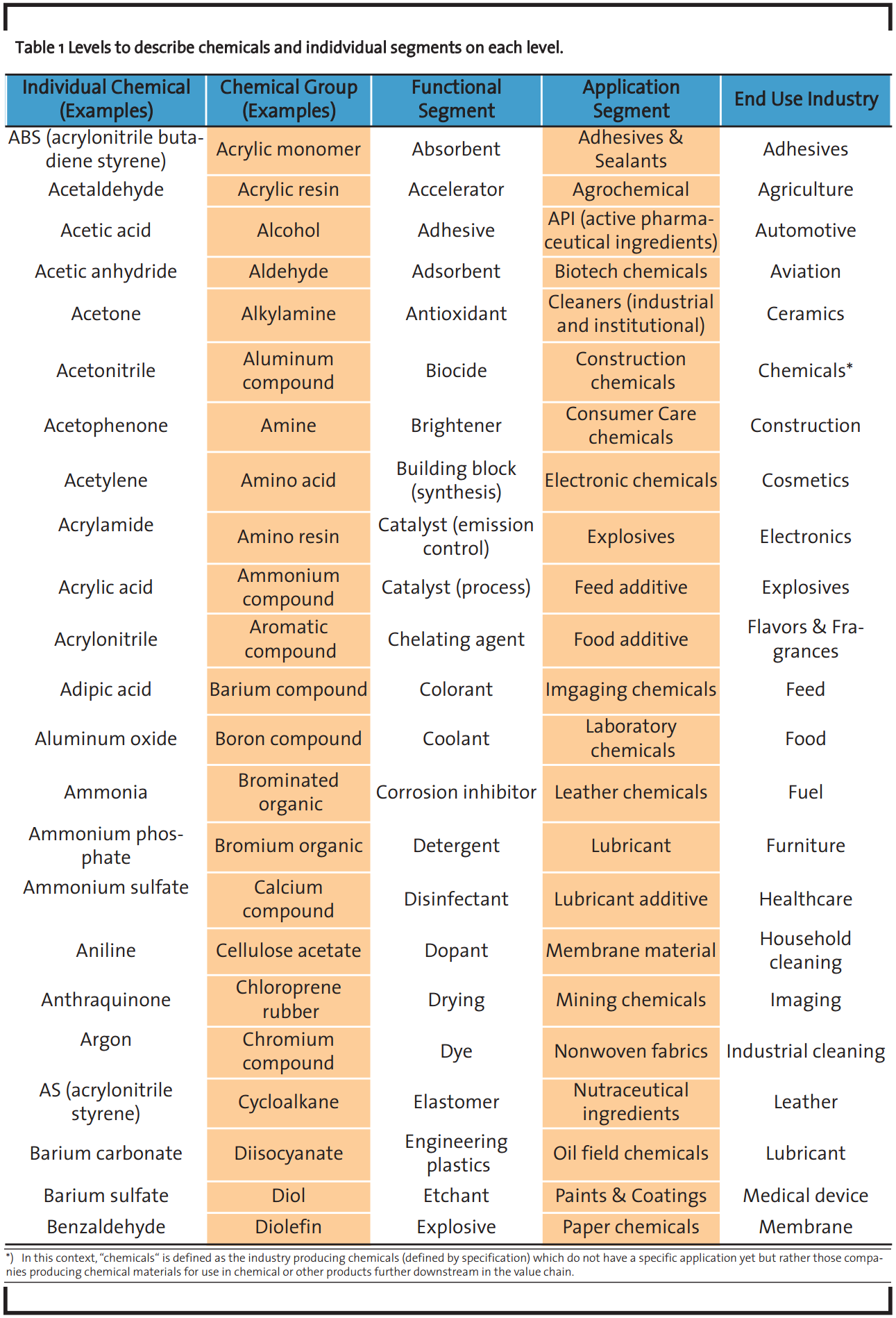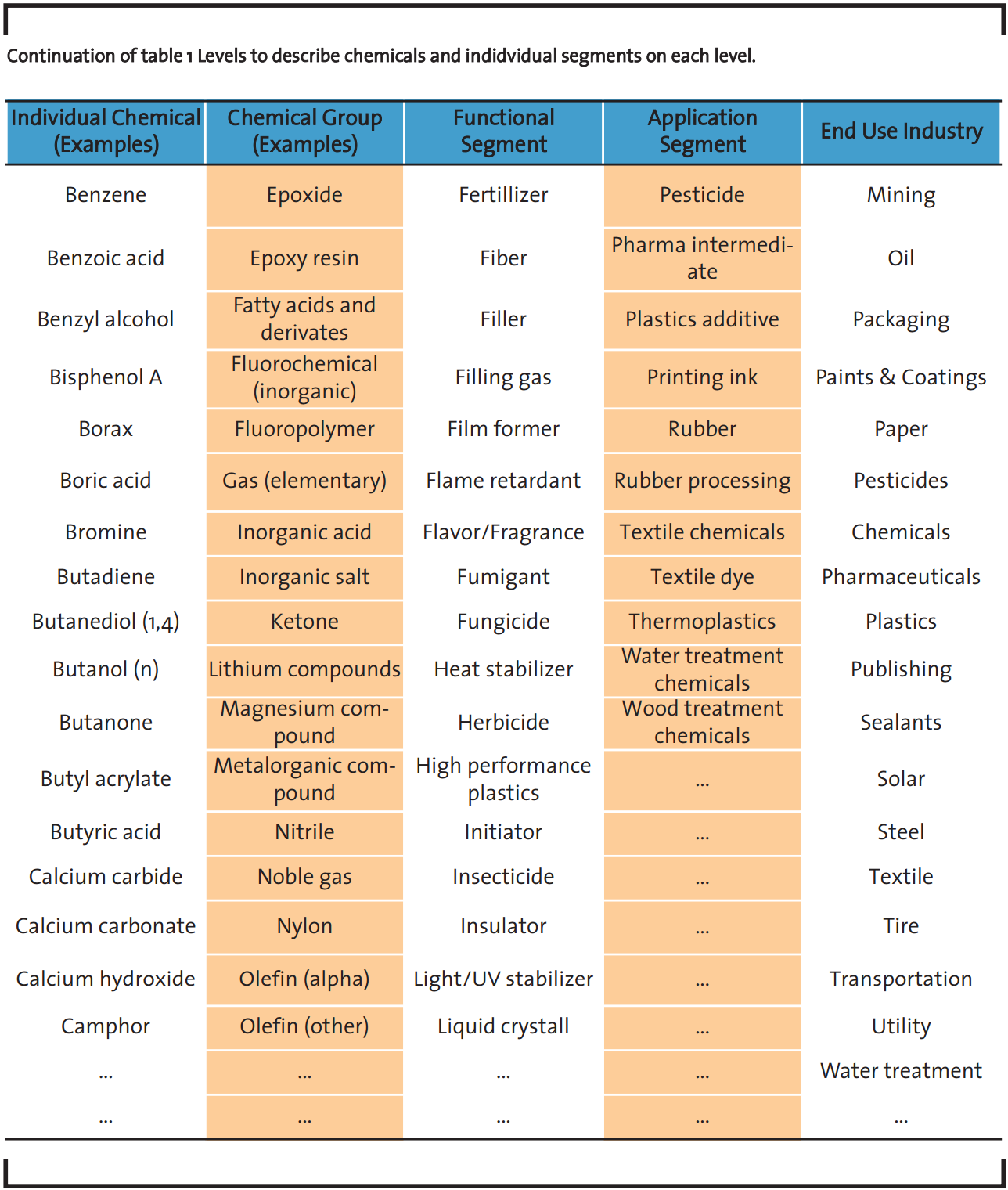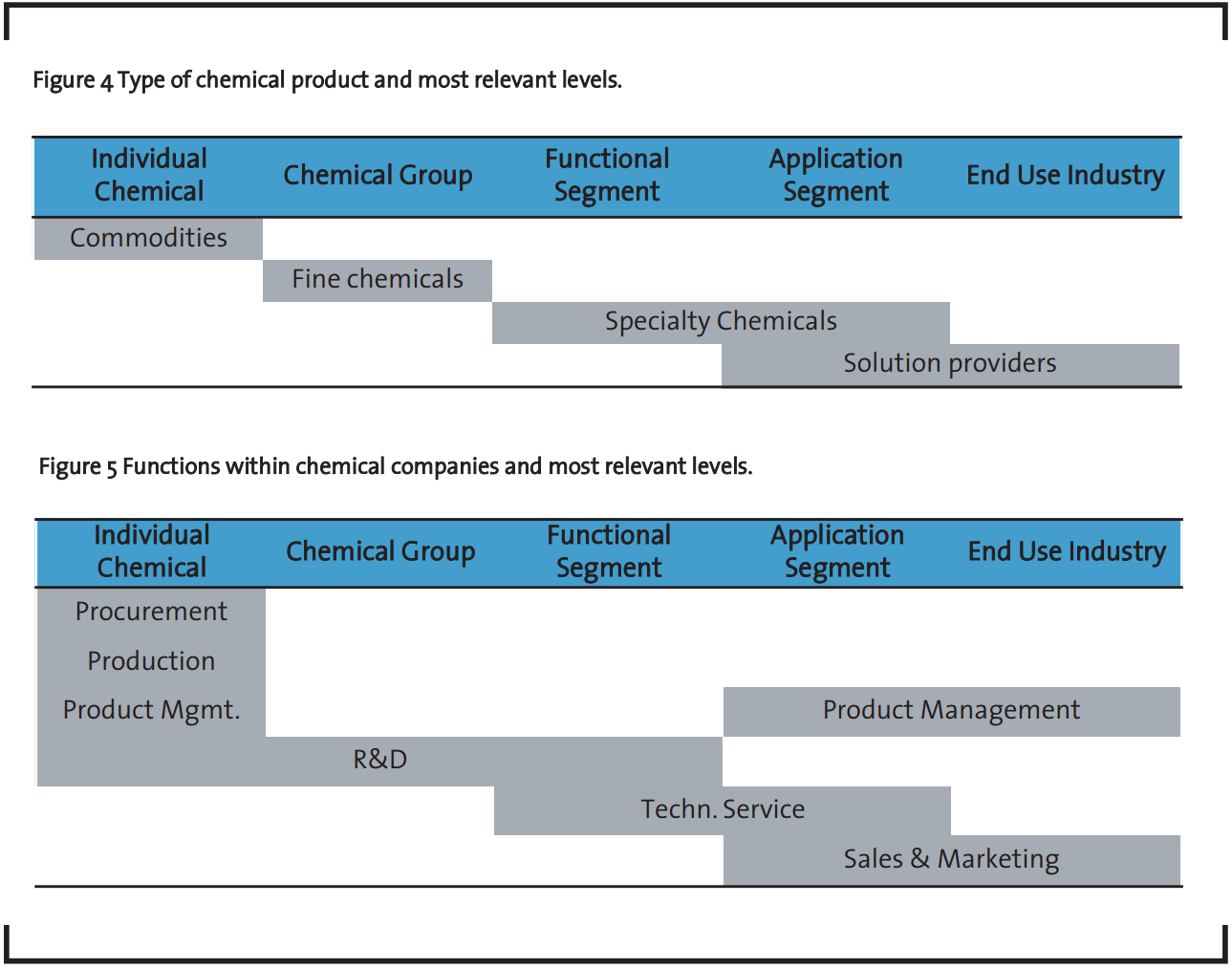Classification of chemicals in the commercial area
Abstract
In the commercial area, classification of chemicals is not as straightforward as in the scientific area. Depending on the perspective taken, different levels can be utilized – moving from segments consisting of individual chemical compounds to the other extreme of segments only defined by the end-use of chemicals. In between, there are several other levels in which both perspectives are mixed to a certain degree. The different levels are discussed along with the issues arising from their often simultaneous use. In addition, guidelines are given on the suitability of different levels for specific areas of the chemical industry.
1 Introduction
In the chemical industry, different chemical products, groups of chemicals, functions, and end uses are frequently utilized as a structural and organizational framework:
- Evonik has six business units (BUs), i.e. Consumer Specialties, Health & Nutrition, Inorganic Materials, Coatings & Additives, Performance Polymers, and Advanced Intermediates (Evonik, 2013).
- Typical market reports for the chemical industry cover such topics as, e.g., polypropylene, aromatics, surfactants, paint additives.
- Individual positions in chemical companies are often responsible for specific products (e.g., key account managers), functions of chemicals (e.g., technical service specialists), and end uses (e.g., end-use managers).
- From the customer side, requests may come for specific chemicals (e.g., from procurement), for test materials with shared functional groups, or for materials suitable for a specific end-use industry.
Taking the Evonik case as an example, the classification utilized for their products uses several levels at the same time and thus has considerable potential for creating confusion. Three of the six segments (Consumer Specialties, Health & Nutrition, Coatings & Additives) are primarily defined by specific end use industries. One (Inorganic Materials) is loosely based on chemical similarities, one on a combination of function and chemical properties (Performance Polymers), and one on the position in the overall chemical value chain (Advanced Intermediates) (Evonik, 2013). Like a shoe shop offering different departments for red shoes, for men´s shoes, for large-size shoes, and for leather shoes, the approach mixes a number of different perspectives, and it is far from clear that the outcome is serving its purpose.
Practitioners in the chemical industry are sometimes only vaguely aware of these different perspectives. Even if they are aware of this issue in principle, it is not well defined how many different levels are commonly utilized and what the individual segments are on each level. The issue is further exacerbated by the tendency of chemical companies to each use their own market definitions, preferably if this allows them to claim market leadership in segments with a questionable underlying rationale.
This paper aims to describe the individual levels on which chemicals are frequently categorized. The core hypothesis is that 5 different levels are frequently utilized, also often in parallel, without the users of the classification being fully aware of the resulting inconsistencies. As a consequence, substantial problems may arise in managing a chemical business. These problems include duplication of research efforts, reduced leveraging of synergies, and unclear responsibilities for specific product-customer combinations. An additional goal of the paper is to give some guidance about which categories are the most suitable in specific situations.
In the context of this paper, a number of terms with specific definitions will be used. The term “Classification” describes the overall process of grouping different items. A classification may be done using different levels as a basis for the classification process. Therein, “Level” is the basic ordering principle which forms the basis of the classification. Within each level, there are different “Segments”, the different items used to subdivide each level. To give an example: If the objective is to classify all objects in one room, this overall process is called classification. Levels (i.e., ordering principles) used to achieve this classification are, e.g., color, size, weight, use, etc. Within the level “color”, different segments are, e.g., green, blue, red, etc.
2 Classification Levels
2.1 Most commonly used levels
The 5 levels most commonly used move from purely chemical ordering principles to those that are more and more oriented towards the end-user industries. These levels are as follows:
- Individual chemicals (e.g., hydrogen peroxide)
- Chemical groups, i.e., groups of chemicals with chemical similarities (e.g., aromatics)
- Functional segments, i.e., segments defined by the function/property of chemicals in end products (e.g., surfactants)
- Application segments, i.e., segments defined by customer industry (e.g., paint additives)
- End-use industry (e.g., coatings).
2.2 An Example
Figure 1 shows which 5 different levels might be used simultaneously for a single common molecule, BHT (2,6-di-tert-butyl-4-methylphenol). In this figure, only one example is given for each level – in reality, most chemicals fall into more than one segment in at least some levels (see figure. 2).
- On the first level, “Individual Chemical”, BHT has a chemical name. This name describes exactly the chemical entity and is thus defined by a specific formula, CAS number, chemical properties, and structure. In principle, each chemical compound has only one official IUPAC name. In reality, there is often a wealth of other commonly used names, particularly in a more technical than chemical environment.
- The next level, “Chemical Group”, contains segments of chemical substances that share a common functional group or a specific other component, i.e., that from a chemical perspective form well-defined groups. For these chemical groups, there is a hierarchical (rather than a single) set of segments. For example, BHT can be described as an aromatic compound or a modified phenol. In addition, many chemicals have more than one characteristic chemical group and thus may belong to multiple segments on the same level.
- The level “Functional Segment” looks at chemicals from the perspective of a property that a specific chemical may contribute to a finished product, or a physical/chemical function a substance may have in a product. Here, the focus has already shifted away from the chemical perspective. Chemically, substances with similar function may have very different composition. For example, other common antioxidants are not based on sterically hindered phenols but on amines, unsaturated functions etc. Again, many chemical compounds will have more than one function, either because they contain more than one chemical group or because a specific chemical group has more than one function.
- The level “Application Segment” contains segments that are commonly used as market segments within chemicals, as in the example of BHT (“Paint Additive”, they frequently are combinations of broad functions (“Additive”) with specific target industries (“Paint”)). Chemically, substances within the same application often have no relationship to others. For example, “Paint additives” also includes UV stabilizers, rheology modifiers, surfactants, catalysts etc., which share no specific chemical characteristics. As before, a specific chemical may have numerous applications. To give another example, BHT does not only belong to the segment of paint additives but also to the segments of cosmetics additives, food additives, fuel additives, pharmaceutical additives, and rubber additives
- Finally, the level “End-Use Industry” utilizes the customer industries of chemicals as segments. Obviously, many chemicals such as BHT also go to a variety of (different) end-uses, as already indicated by the application level, and thus belong to more than one end-use segment.
2.3 From many chemicals to fewer applications and end customers
For the number of segments on each level, there is a broad trend towards a smaller number towards the end-user side (see figure 3). While there are tens of thousands of commercially available chemicals, the number of end industries is well below 100, unless a very narrow definition of the industries is used.
2.4 A first draft of existing levels and segments for the chemical industry
A first attempt is made to provide a list of the individual segments on each of the 5 levels outlined above. This list will only give some examples, particularly for the first level (Individual Chemicals, where only some examples of the first few items of commercially available chemicals are listed) and the second one (Chemical Groups) but aims to be somewhat more comprehensive for the more limited number of segments on the levels of Functions, Applications and End Customers (see table 1). Nevertheless, such a list can clearly only represent an illustration of the principle at this stage. Preparation of a definite list will require a much broader participation of a variety of industry experts.
3 Issues arising from these levels
In itself, utilizing these different levels in parallel is not an issue. However, it can easily turn into a complication if users are not aware of the obvious nonalignment of the different levels. For example, it may easily happen that within one company, there are product managers for individual products (e.g., hydrogen peroxide), for chemical groups (e.g., silicones), for functions (e.g., defoamers), and possibly also for applications (e.g., paint additives). Similar problems arise from defining relevant markets and competitors.
Coming back to the example of BHT, the question is which segment(s) this chemical should be assigned to. The answer is straightforward for the level of “Individual chemicals”. It will probably also not lead to major issues on the next two levels of “Chemical group” and “Functional segment” but will obviously be much more complex on the two levels most closely related to customer industries, “Application segment” and “End-use industry”. Here, it will be impossible to assign only one segment to BHT unless the producing company is willing to restrict itself to only a small share of the total BHT market. The solution commonly employed to deal with these issues is to create overlaying structures of responsibilities based on different levels (see discussion below), which obviously leads to additional internal complexity.
Chemical companies use classifications for a purpose. One key objective is to decrease internal complexity and/or human resource requirements. Instead of having one person responsible for each segment on each level, which would either require a huge number of staff or massive multiple assignments to each employee, certain responsibilities are bundled. This bundling should be done in a way that it allows for some specialization of the employee responsible. This would not be achieved if the bundling was done randomly. Therefore, there is a strong case to be made for using classifications as means to allow for specialization while at the same time limiting the resource utilization.
3.1 What level(s) should a chemical company use as a basis for classification?
Continuing the thought from the previous paragraph, this implies that classifications should generally be based on the level(s) in which the key knowledge areas of a specific chemical company are. Gains from specialization are most likely to be achieved on these levels. What does this mean in detail?
The level “Individual chemicals”, in which each segment consists of only one specific chemical compound, is of somewhat limited use to most companies as it does not cluster chemical products but instead leaves them as individual units. Obviously, this is only reasonable if a company produces only a few bulk commodity chemicals such as acetic acid. It also has to be kept in mind that by using this level, there is essentially no influence of customers and their requirements on the classification. This limits its applicability to those chemicals for which tight specifications exist and which are so common that the buyers do not expect any kind of product information apart from the specifications. Utilizing this level for classification emphasizes the production aspect of a company and is thus suited if production costs are a key success factor.
For the level “Chemical groups”, a key advantage is that the perspective of the research chemist reflects the focus. Chemists involved in more basic research tend to think of molecules as assemblies of different functional groups as there are many similarities in properties and synthetic pathways between chemical compounds carrying the same functional groups. Therefore, this level is particularly suitable for fine chemicals companies as the efficient synthesis of a fairly large number of chemicals via a multitude of pathways appears to be their key knowledge. It may also be suitable for integrated production as it encourages parallel use of similar chemical resources. A danger in using this level is that problem solving may be restricted to specific chemical groups that are the focus of the company (“If you have a hammer, everything looks like a nail”). For example, a company focusing on fluorochemicals for surface treatment may neglect doing research on other chemicals that can achieve the same functions. In the long run, if fluorochemicals fall out of favor due to environmental reasons, such a company may run out of business.
The level “Functional segments” is utilized in a number of specialty chemicals companies that offer solutions to technical problems of customer problems rather than providing specific chemical components such as on the two previous levels. If a food producer is looking for an antioxidant to supplement his food preparation, it is ideal for him to have a counterpart in his supplier company specializing in this function rather than in specific chemicals. Of course, for a company this classification is only meaningful if it can indeed offer various chemicals that achieve the same function. This will then enable the customer with his specific requirements (e.g., regarding price, color, toxicity, stability, etc.) to define the best suited material in discussion with the chemical supplier. Using this level already requires a substantial amount of customer knowledge, if only to be aware of the differences between different chemicals offering the same function. For communication between technical staff of supplier and customer, this level is the most suitable.
Utilizing the level “Application segment”, the requirements for understanding the customer industry are again higher. Here the ownership of the technical problem-solving knowledge has shifted completely to the supplier. On the level “functional segment”, it is shared between supplier and customer while on the two first levels it remained exclusively with the customer. If the preconditions are fulfilled (e.g., sufficient product portfolio, sufficient technical knowledge), this level is ideal for a solution provider in the chemical industry. Such a company would, e.g., be asked by a paint company without strong own technical capabilities to just provide the right mix of paint additives.
Finally, the level of “End-use industry” is useful in two cases. First, if the company focuses almost exclusively on sales of chemicals without offering too much technical service. For example, it is a useful level for chemical distributors. This case has some similarity with the very first one, “Individual chemicals”, in that primarily isolated products are delivered rather than solutions. Second, if the supplying chemical company has such extensive knowledge of the end industry that more or less all the product knowledge comes from the supplier, with the customer only providing production facilities and marketing the product. In either case, meaningful utilization of this level requires a large portfolio for the covered end-use industry – in this case, the supplier may include the offer of “one-stop shopping” among the competitive advantages.
To summarize the key knowledge area of a company will mostly depend on whether it focuses on commodity chemicals, specialties, or providing solutions (see figure 4). The somewhat obvious result of such an analysis is that the more customer- or application-focused the chemical products are, the more an application-oriented level is suitable.
3.2 Different classifications for different functions?
Apart from basing the selection of the most suitable level on the product portfolio of a company, there is another perspective examining the issue from the viewpoint of different internal functions. Again, the question is on which level the different internal functions are most likely to have the highest level of knowledge, as specialization is likely to have the highest benefits on this level.
An analysis following this approach shows that for procurement and for production, the level “Individual chemicals” is the most suitable. Both functions primarily deal with specific chemical entities which they either procure or produce – any gains from having insight into larger segments are likely to be small. In contrast, product management can also benefit from using the levels “Application segments” and “End-use industries” as product managers in chemical companies do not only dealwith the capacity planning and assignment of individual products but also with the marketing of these products. Therefore, for the sales and marketing function, these latter two levels are the most suitable as any synergies from multiple responsibilities will most likely arise from a good knowledge of the applications and end-use industries. For technical staff, the levels “Functional segments” and “Application segments” are the most important as the key knowledge of this function is in the area of the interaction of chemicals with specific products and applications. Finally, the R&D function is likely to benefit from focusing on the first three levels as they are all to some extent related to chemicals and their chemical functions. Figure 5 summarizes these considerations.
However, while using different classifications for different functions will allow each function to focus on its core areas of knowledge, it can also lead to additional issues. For example, the cooperation between Marketing and R&D is likely to suffer if both functions are utilizing different classifications. In addition, even functions such as R&D, which generally focus more on the chemical than the application properties, still need to be aware of the different applications relevant for their products.
3.3 The best level for a specific company
All levels described are being used by different chemical companies, and as stated before, there is not one ideal level for all companies. However, some summarizing trend statements can be made depending on the key strength of a company.
If this strength lies in efficient production, then the level “Individual chemicals” seems to be best suited. For example, Celanese has the business units “Ethanol” and “Cellulose acetate” as these are costdriven bulk chemicals (Celanese, 2013). If the main strength is in innovation, either the level of “Chemical groups” (for chemical synthesis) or the level of “Functional segments” (for specialty chemicals) is preferable. The level “Chemical Groups” is utilized to a large extent by Bayer MaterialScience, reflected in the business units Polycarbonates and Polyurethanes (Bayer, 2013), as well as by Arkema (BUs Fluorochemicals, Acrylic Monomers, Sartomer Specialty Chemicals) (Arkema, 2013). In contrast, the level of “Functional segments” is utilized by Clariant, e.g., as a structural basis for the BU Pigments and the BU Catalysts (Clariant, 2013). Finally, if the focus is on the relationships to end customers, either the level “Application segments” (if technical service is important) or the level “End-use industries” (if shopping convenience is important) are most likely to lead to success. The distinction between these two is often somewhat arbitrary. Lanxess has some BUs based on these two levels, for example, the BU Leather and the BU Rubber Chemicals (Lanxess, 2013).
Of course, there is always the alternative of using more than one level. The increasing popularity of matrix structures in modern chemical companies facilitates such multi-level organizations. A possible approach is to use different levels for different functions. As outlined before, levels on the left-hand side are most suitable for production and procurement functions, the levels in the middle are most suitable for research and technical functions, and the ones on the right-hand side are best suited for sales and marketing operations. Obviously, such an approach brings its own problems. The different functions do not have a single obvious counterpart – the sales manager for paints and coatings may have to deal with 5 or 6 technical segments or in the worst case many more segments on the level of individual chemicals. Finding the right level of complexity is an issue that does not lend itself well to generalization, and indeed companies themselves tend to fluctuate between highly complex and specialized organizations (in which for example three or four of the described levels are utilized) and more streamlined ones (which possibly only use one or two levels) which are more efficient on paper but may not fully utilize market opportunities.
Though it is often hard to argue against increasing specialization and thus the use of a larger number of levels, it should be kept in mind that this often means the same number of levels cannot be utilized outside of a company´s headquarter. For example, in a smaller country utilizing the same number of levels will lead to a perplexing number of functions being held by the same three or four managers, which is highly dysfunctional in itself.
4 Further complications
It merits mentioning that the different levels described in this paper are not the only complication in describing and defining markets. Apart from the levels shown in here, which all basically are defined from the perspective of chemicals, there are other aspects such as processing steps (e.g., closed mold, cold cure for plastics) or on countries/regions. Understanding the issue illustrated in this paper will thus only partly solve the broader problem of confusing and inconsistent market definitions.
5 Outlook
As mentioned above, the suggested list of levels and segments represents only a first draft for a classification that is generally accepted within the chemical industry. Therefore, there is a strong need for discussion and review of the drafted list. In particular, agreeing on the five levels suggested (or alternatively adding or eliminating/subtracting some) would already be a major step in clarifying the overall perspective on the chemical industry. On a more detailed level, it is also suggested to refine the segments given for each level, particularly for those levels with a relatively small number of segments. A formal solution to any initial disagreements may be to add an “Other” segment on each level, though this does not solve the actual problem.
As for the suitability of different levels for specific companies and the related question of utilizing multiple levels within one company, the author suspects that an application of theories employed in other sciences such as sociology may yield further insight. This could be another fruitful approach for further research.
The author greatly appreciates feedback and/or suggestions for alternatives to the proposed classification. The overall objective is definitely not to agree on one or the other level to be the most suitable as this will certainly depend on the specific goals of such a list. However, agreement on a number of basic levels and their main segments will go a long way to increase transparency within the chemical industry, particularly to relative outsiders with limited understanding of the different perspectives currently used.
References
Arkema (2013): Business Units, available at http://www.arkema-inc.com/corporate/business-units, accessed July 19, 2013.
Bayer MaterialScience (2013): Business Units, available at http://materialscience.bayer.com/ company/organization/business-units.aspx, accessed July 19, 2013.
Celanese (2013): Business Units, available at http://www.celanese.com/About-Us/BusinessSegments.aspx, accessed July 19, 2013.
Clariant (2013): Business Areas, available at http://www.clariant.com/corpnew/internet.nsf/vwWebPagesByID/AB7D48C14AA60BF3C1257B6 A0047960C, accessed July 19, 2013.
Evonik (2013): Operational Units, available at http://corporate.evonik.com/en/company/profile-organisation/operational-divisions/ Pages/default.aspx, accessed July 19, 2013.
Lanxess (2013): Business Units, available at http://lanxess.com/en/corporate/productssolutions/business-units/, accessed July 19, 2013
